In the spirit of Madras Week, South First delves into the influence of deep-mapping on shaping community identities that lie beneath the surface of landmarks and streets.

To truly understand why a map was created and what layer(s) of information it offers, the key is to place it in a historical context. (iStock)
A map can mean many things and can take many shapes. In my life, right from the ₹2 world and country maps that I had to get for my Social Studies work, to the Google Maps that I’ve come to rely on today, maps have always played an interesting role.
I fondly and vividly remember the atlas that my brother and I learnt from — quizzing each other about the capitals of countries we had been introduced to through the pages.
Later, with Google Maps forever changing how the our sense of directions worked, I liked zooming in and out of the map to get an idea of where places were, geographically. Quite sillily, I would enjoy looking at my neighbourhood on the maps and getting a sense of the place.
The primary function of a map, as we all are aware, is to geographically situate places and provide directions. But, in reality, maps go beyond these objectives and provide a plethora of other information.
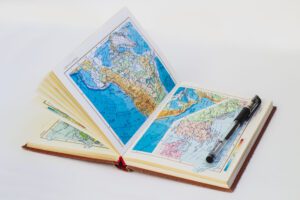
Maps offer us stories through the purposes they were envisioned for. (Wikimedia Commons)
They offer us stories through the purposes they were envisioned for. For instance, a traveller’s map offers insight into roads, transport infrastructure, and the naming of places.
Whereas, a merchant’s map might focus more on the markets and commercial districts, the type of wares sold, and so on.
I read somewhere that “some maps might be designed to facilitate real-life journeys, while there are some designed to facilitate the journey of the mind”. Beautiful, isn’t it?
Like history, maps too follow the individual’s outlook and perspective and tend to reflect certain inherent biases.
To truly understand why a map was created and what layer(s) of information it offers, the key is to place it in a historical context. It is crucial to understand the many layers and form a holistic picture.
One of the essential layers is the structure of a neighbourhood and neighbourhood maps play a vital role here. You and I, as residents of a locality, present a renewed and unique perspective on not just the present state but also the past. Let me give you an example.
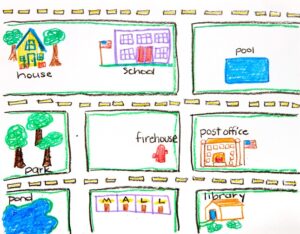
A community map. (Crayola)
I lived a better part of my life in an area called Choolaimedu. I have now moved away, but there’s still a part of me that lives there.
I’m sure that as I am saying this, an area popped into your mind — either the one you’re living in now or the one that you lived in.
When I think of Choolaimedu, I think of my street, my house, the route I now take from my new home to reach my old one, the corner annachi kadai, the therumukku koil, the site of so many old houses now replaced by drab flats, the local pei bungalow — these are all visuals. But is that all memory constitutes?
What about sound and smell? They form crucial navigators and characteristics of a place as well — the kathi saanam vendor whose sharpening sound you hear, the thatha who pushes his cart in peak afternoon to sell ₹10 saaman, the bells of the ice cream vandi, the calls of the anna collecting pazhaiya paper, the smell of puff as I cross the bakery…these are some that I can recollect.
But, if I were to ask any of my family members, they would come up with a wildly different set of things that possess meaning to them.
My paati (grandmother), for instance, would describe a Choolaimedu that existed long before I was even born — her bus travels, her walk to the railway station, the local vendor she used to meet there, her market visits, and so on.

A cycle rickshaw on a city street going past the Law College building. (iStock)
She would rejoice in the camaraderie and exchanges that one could experience on the streets and sigh away as she exits from the past. And, if the same question were to be posed to a kid, the answers would be vastly different, rooted in their needs and desires.
Now, what if each of us put down our perceptions of a neighbourhood on a map? The map doesn’t have to be complicated, relying on cardinal directions and precise points.
It can be a reflection of how your mind experiences and interacts with the neighbourhood, using lines and basic shapes (and colour-coding the spaces if that’s something you enjoy), street names, people, shop names, and more.
Each map is bound to be unique, coloured by the individual’s relationship with the neighbourhood. One map will highlight aspects of the neighbourhood that might not feature in another, having been filtered out due to lack of knowledge/interaction or a conscious decision to not include it. Nevertheless, your map will offer you insights into how your mind dissects and uncovers the layers.
The question then arises: Which map/understanding of Choolaimedu should go down in history?
Should it be the one by the kid who is free from the burden of choices and biases? Or should it be the one that comes from decades of lived experiences? Or, the one that is nuanced and in tune with societal expectations?
The answer lies not in making the most well-informed choice among the options, but in choosing all.
Introducing here the concept of deep mapping that perfectly delivers the message as to why all narratives are important, in their own right.
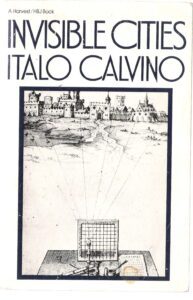
Invisible Cities (1972) by Italo Calvino. (Literary Hub)
Once in class, my professor brought up The Invisible Cities by Italo Calvino, which suggests that every household has two Roman gods — one of them follows the family from place to place, while the other stays in the building and remembers the families that had gone through what it was when the building was still a construction site.
The two exchange and converse stories. Similarly, my professor said, our perspective should be to encourage people to do both — to record the trails of their life and how they go from one place to another, and to record the history of a place and what it has seen and experienced over time.
Lincoln Mullen, a historian, states that one of the challenges in making humanistic maps is to create maps that capture a place, not just space. One of the keys to creating such a map is thinking of places as “gatherings” or “assemblages”.
One author writes how “places gather things”:
Places gather… Minimally, places gather things in their midst — where “things” connote various animate and inanimate entities. Places also gather experiences and histories, even languages and thoughts.
Think only about what it means to go back to a place you know, finding it full of memories and expectations, old things and new things, the familiar and the strange, and much more. What else is capable of this massively diversified holding action? The power belongs to the place itself and it is a power of gathering.
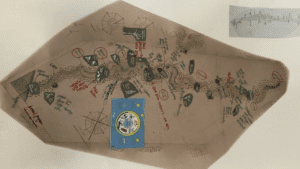
Each map is bound to be unique, coloured by the individual’s relationship with the neighbourhood. (Public History Weekly)
He notes that a deep map tries to uncover these gatherings in the pursuit of explaining the multiple meanings behind a place. After all, people add value to a place; and, places, in general, mean different things to different people. The deep map recognises the slippery identity of the place and seeks to visualise the multiple identities that go towards constructing the human experience of the place.
A deep map, in a way, recognises that there are several different narratives and perspectives, and it is not for us to decide which one is more important. The more we capture the richness of any experience through its multifaceted nature, the better.
And what better place to start than the city that welcomes anyone and everyone with warmth? Constantly tagged as being the “melting point of cultures,” Chennai is an impeccable choice for a case study, to attempt and implement the concept of deep mapping.
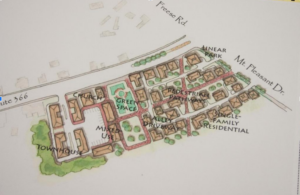
Each map is bound to be unique, coloured by the individual’s relationship with the neighbourhood. (Livingindryden)
If we choose to accept and follow the principles of deep mapping, we will end up with maps that are rich in experiences, characters, and elements, reflecting the true essence of Chennai.
They will enrich the quality and quantity of information available about a neighbourhood. Ultimately, it will contain what general maps don’t — personal narratives, a sense of detail, and noteworthy recollections.
All you need to start is a plain piece of paper, pens/pencils, and an untethered imagination.
(Ashmitha is a heritage professional and architect. She currently heads the work and is a trustee of Madras Inherited.)
(‘Madras 384’ is a curated compilation of articles that joyfully celebrate the captivating journey of Chennai, also known as Madras, while inspiring meaningful discussions.)

May 01, 2024

May 01, 2024

May 01, 2024

May 01, 2024

May 01, 2024

Apr 30, 2024